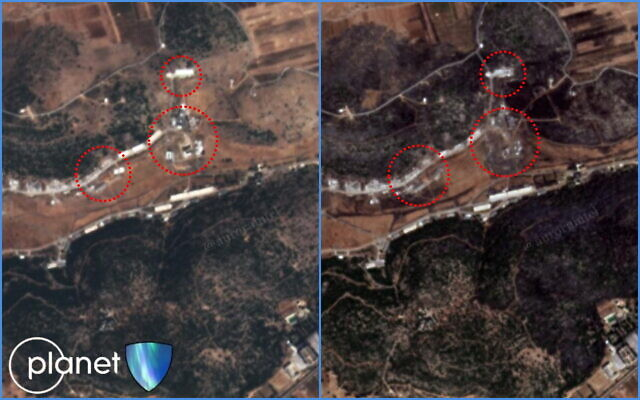
Satellite photos reveal destruction at Scientific Studies and Research Center in Masyaf; firefighting planes try to bring blaze under control two days after attack
Satellite images obtained by The Times of Israel on Saturday showed heavily damaged structures at a Syrian weapons base near the northwestern city of Masyaf in a Thursday airstrike attributed to Israel.
The images taken by Planet Labs PBC and provided by Aurora Intel, a network that provides news and updates based on open-source intelligence, appear to show that some buildings at the Scientific Studies and Research Center, known as CERS or SSRC, on the base were completely destroyed.
Western officials and media reports have long associated the CERS facility with the production of precision surface-to-surface missiles, including the process of casting solid rocket motors, as well as chemical weapons. According to the United States, sarin gas was developed at that center, a charge denied by Syrian authorities.
The area around Masyaf, which is thought to be used as a base for Iranian forces and pro-Iranian militias, has been repeatedly targeted in recent years in attacks widely attributed to Israel. Buildings at CERS specifically have also been targeted numerous times.
Aurora Intel assessed that at least nine buildings were “heavily damaged” in Thursday’s attack, based on viewing satellite imagery from before the attack on Thursday, and new images Saturday.
The group said some of the buildings were apparently directly struck, while others were damaged, potentially by secondary explosions or fires. Additionally, the satellite images indicate that one of the buildings damaged in the attack appeared to have been under construction.
According to the official Syrian news agency SANA, two civilians were hurt in the airstrike attributed to Israel at the site on Thursday evening. Other media in the country reported that one Syrian officer later died of his wounds sustained in the attack.
SANA said damage was caused to the sites that were hit, and that there were fires in the area as a result.
Syrian media reports on Saturday said firefighting aircraft had been scrambled to extinguish the fires in the area, which were still burning nearly two days after the attack.
A satellite image dated Saturday showed a blackened landscape around CERS from the blaze.
Syria: helicopters & firefigting aircraft were brought to control the fires triggered by Israeli airstrikes on weapons/ammo warehouses near Masyaf. Whatever was inside the Scientific Research Facilities, it's unprecedented. pic.twitter.com/ey231hwr90
— QalaatM (@QalaatM) August 27, 2022The UK-based Syrian Observatory for Human Rights, an opposition war monitor with unclear funding, claimed that 1,000 Iranian-made missiles were destroyed at the site in Thursday’s strike.
The unverified claim was widely reported on Hebrew language media, despite the that the organization, run by a single person, has regularly been accused by Syrian war analysts of false reporting, inflating casualty numbers, as well as inventing them wholesale.
Syria: dozens of secondary explosions East of Masyaf one hour after the aerial bombardment. Looks like Israel hit a *major* ammo storage despite regular strikes on this area. pic.twitter.com/nTnXli9E4J
— QalaatM (@QalaatM) August 25, 2022As a rule, Israel’s military does not comment on specific strikes in Syria, but has admitted to conducting hundreds of sorties against Iran-backed groups attempting to gain a foothold in the country. It says it also attacks arms shipments believed to be bound for those groups, chief among them Lebanese Hezbollah.
